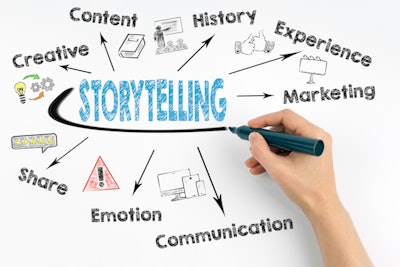
People love stories. Whether we are sitting around a fire, reading a book or watching a video, stories make us feel part of something bigger. They resonate on a deep, human level. That’s why storytelling must be part of every business’s brand strategy — they allow us to connect with customers in a way that not only urges them to buy, but also keeps them loyal.
Stories give us meaning by helping us parse all the stimuli we receive in our lives. They are a powerful way to attract customers because they reach beyond face-to-face communication and enable businesses to express what is distinctly theirs to tell.
Brand strategy is distilling the story of your business. It answers questions like:
• What are you about?
• What are you here to do?
• How will you show up?
• Why should people care?
Once you’ve answered these questions for yourself, you can craft a compelling story about your product to share with your audience.
By defining your brand strategy, you have developed the transcendent story of why your business exists and deserves to exist.
Here are a few tips on how to use storytelling to captivate consumers and keep them for life:
Know that story is the human advantage. Mankind was able to survive because of storytelling. In "Sapiens," historian Yuval Noah Harari explains that story itself contributes to our species’ competitive advantage. Through storytelling we could collaborate, persuade, lead and follow. This resulted in previously unseen large-scale cooperation between large numbers of strangers, including trade, group hunting and migration.
Story facilitated cooperation through trade, and this is what businesses still utilize today. Trade is possible because of cooperation. Cooperation is possible because of storytelling. This is the heart of brand storytelling. The promise of your business is the story of why a person should trade with you. It’s the reason you are allowed to ask them for this trade.
Use story to help your customer resolve tension. In an age when your audience’s mental bandwidth is scarce, tension is a useful tool for capturing and sustaining attention. We recognize our problems in theirs. Therefore, when a storyteller or a business leader sets up a character facing tension, the audience cannot help but listen, be captivated and yearn to experience the resolution. And that satisfying resolution comes in the form of a redeeming event or person or epiphany or product.
While developing your offering, while delivering on your promise and while messaging to customers, keep central on your mind the nature of the problem your customer is experiencing. This will set you up to resolve that tension in a way that satisfies and delights your customer. For example: Your customer wants to enjoy their pool, but they don't have time to maintain it themselves, making it a source of stress in their life (tension). Your pool service company can take care of all the maintenance and enable the customer to enjoy a stress-free swimming experience (resolution).
Use story to persuade. Whether it was joining forces to fend off a predator or to sail across oceans, early humans persuaded and flourished by telling stories. We still persuade through storytelling today. Stories work with the neural wiring of our audience. Facts and claims engage the prefrontal cortex, inviting debate and pushback. Stories circumvent that newer, slower, critical brain. They create an express lane to the brain stem, enabling you to persuade before their prefrontal cortex wakes to the conversation. It enables your Dorothy to skip the judgmental gatekeepers at the entrance to Oz and speak directly with the Wizard himself.
Persuasion is the fundamental challenge of marketing, and storytelling is a powerful tool as you approach this challenge. When you tell stories, your customer is more likely to trust you and to feel they can safely believe your promise. So,use storytelling to set these conditions so that you succeed in persuading your target customer.
Show; don’t tell. Effective storytelling invites the audience to participate. The more participatory your story, the more the audience is moved by it. The best stories show rather than tell, and the highest form of show-don’t-tell is imagery. Imagery is effective because images grab attention instantaneously (remember that 93% of all human communication is visual). Storytelling through imagery is a brand’s superhighway to persuasion.
For example, Tom Dickson, inventor of Blendtec blenders, used imagery to deliver on the promise of “super-powerful blending.” Dressed as a mad scientist, Dickson filmed himself challenging his Blendtec to blend shockingly difficult objects like marbles and iPods. The “Will It Blend?” video so captured our attention that it went viral before “going viral” was a thing.
Use imagery to tell your story. Let photos, graphics and drawings lead while words support. (For pool and spa professionals, this should be easy!) When you do use only words, let the words invite the audience into a story so they picture an image of their own making. The audience then can participate in discovering and developing the message themselves. Since they co-created the message, they will like it, believe it, remember it and share it.
Empathize with your customer. As you bring your promise forward through storytelling, tap into your own empathy for your target customer. Your customer — not your business — should be the hero of the story, and your business exists to help the hero resolve the tension and advance his story. Tell your story in a way that allows your respect for the customer to shine. Before seeking to resonate with them, first seek to let them resonate with you. Before asking them to like you, make sure that you first like, understand and empathize with them.
In the early days of the Great Recession, Seattle’s adored Washington Mutual Bank failed and was subsumed in a shotgun wedding with Chase Bank. Chase plastered this line on busses and billboards throughout the city: “Seattle: Land of coffee, seafood, and now helpful banking.” Chase could have empathetically let Seattleites be the hero and resolve the tension. Instead they positioned themselves to be the hero and insulted Seattleites further.
Contrastingly, PEMCO, another financial services brand, successfully related to the Seattle market during the same era with a campaign featuring humorous images that only insiders would relate to, sparking a sense of community pride and kinship. The caption for each ad was “We’re a lot like you, a little different,” featuring inside jokes like the “Supercharged Seahawks Fan,” “Recumbent Bike Commuter,” and “Oblivious Left Lane Occupant.” PEMCO did the opposite of what Chase did. Instead of presuming a superior place at the family table, they became one of us. They felt the zeitgeist, and made the Seattleite the hero of the story.
Your brand strategy is incomplete without your story. For humans doing business, story connects, persuades, resolves tension and shows the customer your meaning. Embrace your story today and use it to bind you to your business.
Lindsay Pedersen is the author of "Forging an Ironclad Brand: A Leader’s Guide." She is a brand strategist, board advisor, coach, speaker, and teacher known for her scientific, growth-oriented approach to brand building. She developed the Ironclad Method for value-creating brands while working with billion-dollar businesses like Starbucks, Clorox, Zulily, T-Mobile and IMDb, as well as many burgeoning start-ups. Pedersen lives in Seattle with her husband and two children.











































